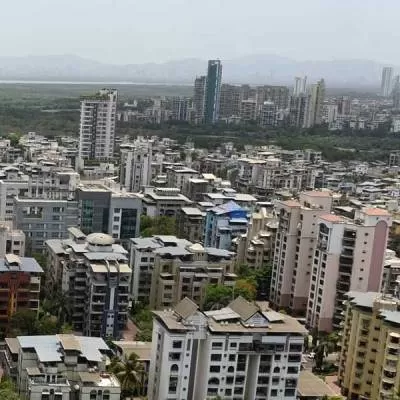- Home
- Real Estate
- Bright prospects for energy-efficient, space and money saving, easily installable products that cater to highly polluted Indian conditions
Bright prospects for energy-efficient, space and money saving, easily installable products that cater to highly polluted Indian conditions
<span style="font-weight: bold;">While soaring temperatures augur well for the HVAC industry, players also report other reasons to be upbeat. </span><br /> <br /> "We expect to see strong growth in India, combining reasons of huge government funding in infrastructure development projects and rapid population growth in the country," says <span style="font-weight: bold;">Asokdas MD, Managing Director, Systemair, </span>a major player of energy-efficient ventilation products. "We consider India a major market in the region, strategically important to the group as a whole."<br /> "With the overnment pushing healthcare, education and infrastructure, we feel demand for our services is rising in these sectors," says <span style="font-weight: bold;">Hemant Bhange, Managing Director, Zamil Air Conditioners India.</span><br /> "We have started witnessing faster movement on building construction projects, after the lull that followed demonetisation and the implementation of GST," says <span style="font-weight: bold;">Sachin Maheshwari, Director, Caryaire Equipments India. </span><br /> "We expect demand to further grow stronger over the next few months and, perhaps, taper off closer to the general elections."<br /> "Regulation (energy-efficiency norms as well as multilateral agreements limiting the use of certain global warming gases) <br /> and government investment in infrastructure are two demand drivers," as per <span style="font-weight: bold;">M Gopi Krishna, Executive Vice President & COO, Domestic Projects Group, Voltas.<br /> <br /> Size-wise, growth-wise, region-wise</span><br /> Bhange estimates the size of the HVAC market at about Rs 100 billion. Some players target a part of this. For instance, Caryaire Group, a leading provider of air distribution and ventilation products with a pan-India presence, targets a market segment worth over Rs 10 billion.<br /> Largely, room air-conditioners dominate the HVAC market. In this segment, the 2017 calendar year saw 10 per cent average growth but an industry leader, Blue Star, saw room air-conditioner sales grow at around 15 per cent. <br /> B Thiagarajan, Joint Managing Director, Blue Star, is optimistic about future prospects and expects the company to continue to outperform the market.<br /> "Over the next five years, we foresee a CAGR growth potential of at least 10-12 per cent for the HVAC/MEP, water and wastewater treatment and electrical distribution market, which currently stands at around Rs 200 billion," says Gopi Krishna.<br /> Typically, northern India has been the leading HVAC market by region driven by high summer temperatures. However, high humidity levels in the West and South are driving growth in these regions, giving some players reason to strengthen their position in these markets. <br /> For example, Systemair has expanded its production facility in Hyderabad to about 5,000 sq m, bringing it on a par with its <br /> northern Indian production facility, to reflect the growing importance of southern India as a target market. "Local production is vital to compete against the relatively large number of local operators in the ventilation sector," says Asokdas.<br /> <br /> <span style="font-weight: bold;">Energy-efficiency on top</span><br /> The government's strong push on energy conservation with the momentum created by the green building movement has strongly driven demand for energy-efficient designs, products and technologies, says Maheshwari.<br /> "Customers are increasingly demanding energy-efficient and reliable products that meet the need for lowest first cost and lowest lifecycle cost, the latter to impose the lowest additional burden on the building owner," agrees <span style="font-weight: bold;">Basanth Kumar, National Sales Manager, India, Armstrong Fluid Technology.</span><br /> Nowadays, the focus is on energy-efficient design that has a minimal impact on the environment and natural resources, according to Bhange. "Energy-efficient VFD-operated chilling plants are preferred, and usually paired with heat-reflecting glass façades that allow sunlight in to minimise the need for lighting, and better insulation on the rooftop, indoor air quality monitoring, etc."<br /> Providers are responding to this trend with an ever-expanding range of energy-efficient products and solutions.<br /> This year, Blue Star has launched 40 3-star and 5-star inverter split air-conditioner models meeting 2018 BEE energy-efficiency norms. <br /> With 'Precision Cooling Technology', these can deliver precise cooling in decimals, as accurate as 0.1<span class="st" data-hveid="46" data-ved="0ahUKEwi76ePUi_jaAhWIKo8KHX6wC-kQ4EUILjAA">°</span>C or 0.5<span class="st" data-hveid="46" data-ved="0ahUKEwi76ePUi_jaAhWIKo8KHX6wC-kQ4EUILjAA">°</span>C. <br /> With 'Dual Rotor Technology', they offer faster cooling, quieter operations and longer durability.<br /> According to Thiagarajan, "Our new 5-star inverter air-conditioner will save about 70 per cent of the energy consumed by an air-conditioner rated 1 star on the previous energy scale, or 95 per cent of the energy consumed by an air-conditioner bought in the year 2000, or 40 per cent more energy than that consumed by a regular 5-star air-conditioner."<br /> Caryaire's energy-efficient ventilation products, when combined with effective design and controls, can reduce the building's ventilation load by 40-50 per cent and the total building energy load by 10-15 per cent. For instance, a new ventilation DC brushless fan solution can save up to 40-50 per cent of the energy consumed by a traditional fan system, with a payback of less than one to two years on the additional investment. Using a high-volume, low-speed ceiling fan in a warehouse or other space with a high ceiling can reduce the fan energy load by 90-95 per cent as well as bring down the effective temperature, thereby creating additional savings on air-conditioning or air-cooling requirements. Maheshwari explains this is because a single fan of 24-ft diameter with a rated load of just 1.5 kW can effectively cover up to 15,000 sq ft, where, traditionally, at least 20 wall-mounted fans, each with a rated load of 1 kW, would have been installed.<br /> <br /> <span style="font-weight: bold;">Customer preferences</span><br /> Customers tend to ask for variable refrigerant volume (VRV) technology-based solutions nowadays, says <span style="font-weight: bold;">KL Maheshwari, CEO, Maheshwari Consultants.</span><br /> While this choice is largely driven by the ubiquitous need to trim energy bills, the right decision on the HVAC system depends on many factors.<br /> <br /> "In general, systems of 100-200 tonne capacity are based on VRV technology while systems of size greater than 300 tonne for larger spaces work out to be cost-effective with the use of a chiller plant," explains KL Maheshwari. "VRV technology is easier to manage and operate but works efficiently in locations where the outdoor air temperature does not exceed 35<span class="st" data-hveid="46" data-ved="0ahUKEwi76ePUi_jaAhWIKo8KHX6wC-kQ4EUILjAA">°</span> C. Also, VRV/VRF systems are designed for comfort application and light duty, while chiller systems are designed for 24+7+365 operations. Additionally, the chiller unit can maintain the indoor air quality and the required relative humidity."<br /> <br /> Another interesting observation on customer preference by Thiagarajan is that consumers of room air-conditioners are quite brand-conscious, preferring specialist air-conditioning players offering a high-quality product array. Blue Star's experience shows that many consumers in smaller towns also demand premium products as in the bigger towns. "Around 52 per cent of Blue Star's room air-conditioner sales are from smaller towns," he points out.<br /> <br /> <span style="font-weight: bold;">Space and time savers</span><br /> VRV technology is believed to help developers maximise indoor space and minimise the mechanical footprint for saleable or leasable square footage. However, "with the use of ceiling suspended units, the choice of an air-conditioner does not impact the available floor space," notes <span style="font-weight: bold;">KL Maheshwari.</span> A VRV air-conditioning plant is usually installed on the rooftop or terrace while a chiller plant room is usually created in a basement.<br /> To save space, especially in buildings featuring innovative designs, Armstrong recommends integrated technology products. "Integrated technology products can help save 40-50 per cent of the space occupied by traditional products," says Kumar. <br /> "A space and cost-saving trend in commercial buildings is to eliminate the false ceiling in lieu of true ceiling technology," notes <span style="font-weight: bold;">Sakthiveeran S, Design Manager, South India, ABS Aircon Engineers.</span> "This involves painting the HVAC ducts, diffuser and volume control damper, electrical and building management system and fire pipes black, to improve aesthetics."<br /> To help meet project deadlines, solutions that may be quickly installed are also preferable. "Pre-engineered, factory-built solutions such as pump packages and pump rooms help reduce installation time and site risks," suggests Kumar.<br /> <br /> <span style="font-weight: bold;">Connected systems</span><br /> To offer proactive monitoring, Voltas, a leading provider of solutions as well as operations and maintenance services, has invested in Internet of Things (IOT) technology. "IOT is a platform we have leveraged well on our products in our journey from breakdown maintenance to preventive maintenance and progressing towards predictive services," says Gopi Krishna.<br /> "We recommend connected products (IOT) for sustained performance," says Kumar.<br /> Connectedness also relates to links with sensors, the use of which is growing. <br /> "In many IT parks especially, to control costs, sensors are increasingly being used to automate the air-flow rate and get precise control on a room's air conditions," says Sakthiveeran. "The sensors are linked to the variable air volume controller using Power over Ethernet (POE) technology."<br /> <br /> <span style="font-weight: bold;">Associated products</span><br /> To cater to rising concerns about the quality of the indoor environment, an outcome of growing outdoor air pollution, Caryaire has started manufacturing air-purification products taking care of a larger number of pollutants, chemicals, bacteria and micro-organisms, a first in India.<br /> "We see a growing market for air-purification products designed for severe Indian pollution conditions, of sizes suitable from a residential room to large spaces," says <span style="font-weight: bold;">Sachin Maheshwari.</span><br /> Also, growing awareness of building safety and the close ties between centralised air-conditioning ducts and the spread of fire and smoke are spurring demand for fire control and smoke management solutions such as fire dampers and smoke-spill fans, says <span style="font-weight: bold;">Sachin Maheshwari.<br /> <br /> What's next?</span><br /> Voltas was the first player to associate with the concept of net-zero energy buildings with Indira <span style="font-weight: bold;">Paryavaran Bhawan,</span> an initiative by the Ministry of Environment where high-efficiency solar panels help achieve the net-zero criteria. Since then, <br /> Voltas has also introduced radiant cooling systems and under-floor cooling to substantially reduce the energy footprint of buildings. <br /> <br /> Indeed, the future belongs to cutting-edge technologies that will take energy-efficiency to the next level.<br /> <br /> <span style="font-weight: bold;">- Charu bahri</span><br />




















